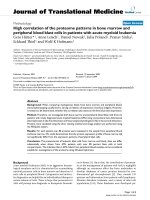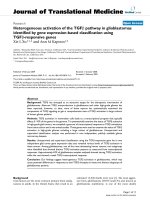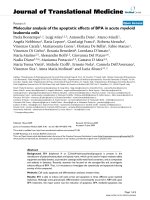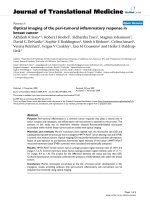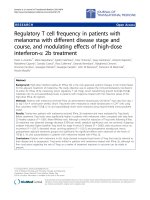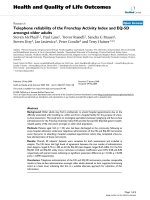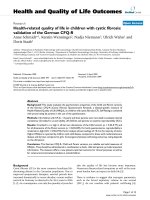báo cáo hóa học: " Health-related quality of life in children with cystic fibrosis: validation of the German CFQ-R" potx
Bạn đang xem bản rút gọn của tài liệu. Xem và tải ngay bản đầy đủ của tài liệu tại đây (276.08 KB, 10 trang )
BioMed Central
Page 1 of 10
(page number not for citation purposes)
Health and Quality of Life Outcomes
Open Access
Research
Health-related quality of life in children with cystic fibrosis:
validation of the German CFQ-R
Anne Schmidt*
1
, Kerstin Wenninger
2
, Nadja Niemann
3
, Ulrich Wahn
1
and
Doris Staab
1
Address:
1
Department of Paediatric Pulmonology and Immunology, Charité Universitätsmedizin Berlin, Campus Virchow Klinikum,
Augustenburger Platz 1, 13353 Berlin, Germany,
2
Department of Paediatric Haematology-Oncology, University of Freiburg, Mathildenstrasse 1,
79106 Freiburg, Germany and
3
Centre for Quality Management in Health Care, Berliner Allee 20, 30175 Hannover, Germany
Email: Anne Schmidt* - ; Kerstin Wenninger - ; Nadja Niemann - nadja.niemann@zq-
aekn.de; Ulrich Wahn - ; Doris Staab -
* Corresponding author
Abstract
Background: This study evaluates the psychometric properties of the Child and Parent versions
of the German CFQ-R (Cystic Fibrosis Questionnaire Revised), a disease-specific measure of
Health-Related Quality of Life (HRQoL) in children with cystic fibrosis (CF). Self-Rating is combined
with proxy-rating by parents in the use of the questionnaire.
Methods: 136 children with CF (6 - 13 years) and their parents were recruited to evaluate internal
consistency (Cronbach's α) and validity, 20 children and parents to examine reproducibility (ICC).
Results: Cronbach's α is high in all but two dimensions of the Child version (α = 0.23-0.77) and
for all dimensions of the Parent version (α = 0.69-0.89). For both questionnaires, reproducibility is
moderate to high (ICC = 0.50-0.94). Factor analysis shows loadings of >0.4 in the majority of items.
Higher HRQoL is reported by children with mild disease compared to those with moderate/severe
disease and by boys compared to girls. Convergence between self-rating and proxy-rating depends
on the dimension.
Conclusion: The German CFQ-R, Child and Parent versions, are reliable and valid measures of
HRQoL. They should be administered in combination as both, child and parent, provide important
information. The measure offers a new patient-reported outcome for clinical purposes as well as
for national and international studies in schoolchildren.
Background
Cystic fibrosis (CF) is the most common hereditary life-
shortening disease in the Caucasian population. Due to
improved symptomatic therapies, survival periods have
increased dramatically in recent decades; current median
survival in Germany is observed to be 38.6 years in 2006
[1,2]. As a consequence, not only the quantity of years but
also the quality of life has become more important.
Numerous disease-related symptoms as well as the treat-
ment burden have an impact on daily life [3].
There is evidence to suggest that surrogate parameters,
such as the forced expiratory volume in one second
(FEV
1
), do not correlate with patients' well-being [4].
Published: 2 December 2009
Health and Quality of Life Outcomes 2009, 7:97 doi:10.1186/1477-7525-7-97
Received: 16 April 2009
Accepted: 2 December 2009
This article is available from: />© 2009 Schmidt et al; licensee BioMed Central Ltd.
This is an Open Access article distributed under the terms of the Creative Commons Attribution License ( />),
which permits unrestricted use, distribution, and reproduction in any medium, provided the original work is properly cited.
Health and Quality of Life Outcomes 2009, 7:97 />Page 2 of 10
(page number not for citation purposes)
Therefore, there is a growing need for such patient-
reported outcomes (PROs) as Health-Related Quality of
Life (HRQoL) [5]. The latter is defined as a multi-dimen-
sional construct which allows awareness of a patient's
subjective perception of the disease and the daily limita-
tions they face [6]. There are various possible ways of
assessing HRQoL. The importance of using disease-spe-
cific instruments especially in patients with CF has been
described in detail [5,7-11].
There are three disease-specific instruments that are cur-
rently available for patients with CF; among them, the
CFQ (Cystic Fibrosis Questionnaire) is the only one with
age appropriate versions [11-13]. It was originally devel-
oped in France and then translated into several languages.
Translation into German followed international recom-
mendations and was described by Wenninger et al. [8,14].
The first German Child and Parent versions were tested in
n = 44 children and their parents, but showed unsatisfac-
tory psychometric properties (Wenninger, personal com-
munication). The first US versions showed the same
unsatisfactory psychometric properties. For this reason, a
revision of the German questionnaires, including those
for adults and adolescents, was carried out in cooperation
with A. Quittner's group in the USA [8,11,15-17]. Revi-
sion involved the deletion and rewording of several items.
The Revised CFQ, CFQ-R, showed good psychometric
properties for the German versions for adolescents (CFQ-
R 14+) and adults (CFQ-R 18+) [8]. The German CFQ-R
versions are identical to the US versions of the CFQ-R [17]
except for the language. Meanwhile, the versions for ado-
lescents and adults are validated in a variety of languages,
e.g. in French, German, English, Dutch and Danish, which
enables researchers to undertake international multi-cen-
tre studies [8,11,15,16,18-21].
International studies on HRQoL in children are needed to
gain a better understanding of the impact of public poli-
cies, interventions, therapies, and treatments [22]. Data
on psychiatric problems in children with CF are heteroge-
neous, some studies indicate a higher incidence of psychi-
atric, psychosocial, emotional, and educational problems
in children with CF than in their healthy peers [23,24]. In
all age groups of patients with CF, depression shows
higher rates than in healty populations, which might have
a negative impact on adherence, family functioning and
HRQoL [25]. In spite of the fact that measures for HRQoL
are not able to record all impacts of a disease on daily life,
they allow investigations in large populations.
Considering the advances in CF therapy and with regard
to the recent increase in interest in PROs, the German
CFQ-R, Child, and Parent versions are necessary tools for
including schoolchildren in the analysis of HRQoL in
patients with cystic fibrosis.
This study tests the psychometric properties of the revised
German version for children aged 6 to 13 years (CFQk-R,
here called "CFQ-R, Child version") and their parents
(CFQe-R, here: "CFQ-R, Parent version"). It is hypothe-
sized that the questionnaires are objective, reliable, and
valid measures for HRQoL in schoolchildren with CF.
Methods
Participants and procedures
Children aged 6 to 13 years and their parents were
recruited for the HRQoL survey during routine visits to the
outpatient clinics of 10 German CF centres participating
in the Benchmarking Project, which has been described in
detail by Stern et al. [2]. The number of children of this
age who participated in the Benchmarking Project in 2005
was 293, and 136 of these children (46%) could be
included in this study. Only patients from one centre (n =
28) were accessible for test-retest reliability. Eight of them
had to be excluded from the analysis due to the worsening
of their condition after the first use of the questionnaire,
leading to a final number of 20 patients in this subgroup.
Approval was given by one local ethical committee (Uni-
versity of Tübingen) and accepted as representative of all
participating CF centres. Age, sex, lung function (forced
expiratory volume in one second, FEV
1
), nutritional state
(weight for height, WH) and infection with Pseudomonas
aeruginosa were assessed. The following inclusion criteria
had to be met by the patients and parents: (1) diagnosis
of CF either by positive sweat test or two identified CF
mutations, (2) age 6 to 13 years, (3) ability to read and
speak German, (4) assent of the child and written
informed consent by the parents. Furthermore, patients
for the evaluation of test-retest reliability had to remain in
stable health and life conditions after the first survey for at
least two weeks according to parents' and patients report.
The questionnaires were used before the physician was
consulted. In the test-retest sample, the second survey
took place either at the patient's home or at the CF centre.
Participation rate was 136 out of 293 patients who were
treated at the ten CF centres taking part in the Benchmark-
ing Project. Children are characterized in table 1. The sta-
ble subgroup to determine test-retest reliability consists of
20 patients with comparable characteristics. Compared
with the cohort of 293 patients aged between 6 and 13
treated at the participating centres during this period, the
patients included in this study have a lower percentage of
children with good lung function and nutritional state.
Time elapsed from the communication of diagnosis to the
test administration was more than one year in all patients.
Measures
The questionnaire
The German CFQ-R, Child version, is a self-rating ques-
tionnaire consisting of 35 items grouped into eight
dimensions of HRQoL; the Parent version is a proxy-rat-
Health and Quality of Life Outcomes 2009, 7:97 />Page 3 of 10
(page number not for citation purposes)
ing questionnaire with 43 items and eleven dimensions
where parents report on their child's HRQoL. Some
dimensions are exclusively represented in one of the two
questionnaires. Table 2 shows details on dimensions, the
number of items and representative items. All items are
shown in additional files 1 and 2. The different scales cor-
respond with five generic and three disease-specific
dimensions of HRQoL, three symptom scales and a rating
for "Subjective Health Perception". The questionnaire is
self-administered by parents and by children between 11
and 13 years after checking for adequate reading skills;
children between 6 and 10 years are interviewed and
choose the answers from a special answering card. Items
are in German and refer to a time frame of the preceding
two weeks. In the Child version they are answered on a
four-point Likert scale either on a true-false rating ranging
from "not at all true" to "very true", or on a frequency
response ranging from "never" to "often". In the Parent
version, similar four-point Likert scales are used supple-
mented by five items with 4 eligible standard phrases for
answer selection. Some items are recoded and then the
score for quality of life is calculated on a scale between 0
(low) and 100 (high).
Table 1: Characteristics of the patients
Whole sample
n = 136
Test-retest sample
n = 20 (subgroup)
Benchmarking population n = 293
Age of the child in years (mean) 10.2 (SD 1.9)
(range 6-13)
9.6 (SD 2.6)
(range 6-13)
9.8 (SD 2.3)
(range 6-13)
FEV
1
(mean) 86% (SD 19)
(range 31-125)
81% (SD 21)
(range 41-109)
94% (SD 20)
(range 31-159)
Percentage of children with FEV
1
>80% 68% 50% 80%
WH (mean) 97% (SD 12)
(range 68-141)
94% (SD 9)
(range 78-108)
99% (SD 12)
(range 68-146)
Percentage of children with WH >90% 74% 65% 80%
Boys 55% 75% 49%
Mother completing CFQ-R-Parent 71% 85%
Father completing CFQ-R-Parent 27% 15%
Other person completing CFQ-R-Parent 1% -
FEV
1
forced expiratory volume in one second in % predicted
WH weight for height in % predicted
Benchmarking population: Population of children with cystic fibrosis assessed in a project that was initiated to improve the quality of care for
patients in Germany. The project was described by Stern et al. [2]
Table 2: The German CFQ-R, Child and Parent versions
CFQ-R Child version CFQ-R Parent version Item examples for each dimension
Dimensions of Health-Related Quality
of Life
(no. of items) (no. of items)
Physical Functioning 6 9 "Child was able to run, jump and climb as it
wanted."
Energy - 5 "Child seemed energetic."
Emotional State 8 5 "Child felt worried."
Social Limitations 7 - "Child felt left out."
School Performance - 3 "Child has trouble concentrating."
Body Image 3 3 "Child felt physically different from others."
Eating Disturbance 3 2 "Child was pushed to eat."
Treatment Burden 3 3 "Child was bothered by undergoing the
treatments."
Subjective Health Perception - 3 "Child leads a normal life."
Respiratory Symptoms 4 6 "Child coughed during the day."
Digestive Symptoms 1 3 "Child's stomach hurt."
Weight Problems - 1 "Child had trouble gaining weight."
No. of dimensions 811
No. of items 35 43
Health and Quality of Life Outcomes 2009, 7:97 />Page 4 of 10
(page number not for citation purposes)
Measures of health state
All data on health state are obtained by standardized pro-
cedures and reported to the German Registry database.
Pulmonary function tests are performed to measure lung
function. FEV
1
> 80% is regarded as a good physical con-
dition [2]. The established classification of disease severity
differentiates between mild (FEV
1
≥ 70%), moderate
(FEV
1
40-69%) and severe disease (FEV
1
≤ 39%) [26,27].
Only one child with severe disease is included in this
study.
Nutritional state is measured by weight for height. A value
of ≥ 90% is regarded as good. Infection with Pseu-
domonas aeruginosa is assessed by throat swabs or spu-
tum analysis [2].
Statistical methods
Statistical analysis is conducted using the Statistical Pack-
age for Social Sciences (SPSS 13.0) with a level of signifi-
cance of <0.05. For reliability, internal consistency is
calculated using Cronbach's α (α>0.6 expected for all
dimensions) [28,29]. The reproducibility of the results of
the questionnaires is analysed by test-retest reliability
using intra-class correlation (ICC). An ICC value of at
least 0.6 for all dimensions is expected [30]. Construct
validity is evaluated by factor analysis (Principal Compo-
nent Analysis, PCA) to test the given structure of the CFQ-
R. The number of factors is set at 8 for the Child version
and at 11 for the Parent version. Correlation between the
single item and its dimension is tested (item-internal con-
sistency), with a recommended correlation of at least 0.4.
Every item should be more closely correlated with its own
dimension than with others (item-discriminant validity)
[31,32].
Known-group validity is analysed using the T-Test. Com-
parisons are made between patients with mild and mod-
erate/severe disease and between boys and girls. For all
known-group comparisons, T-Tests and χ
2
-Tests for the
detection of possible confounders are performed as post-
hoc analyses.
The convergent validity of the Child and Parent versions
is calculated by ICC. Here, ICC provides information
about the degree of correlation between self- and proxy
rating; high values indicate a higher level of correlation.
Results
Reliability
The data on n = 136 children are analysed for internal con-
sistency (see table 3). For the CFQ-R, Child version, Cron-
bach's α is >0.6 in the dimensions "Physical Functioning",
"Emotional State", "Eating Disturbance" and "Respiratory
Symptoms". It is 0.57 in the "Body Image" dimension.
Two dimensions ("Treatment Burden", "Social Limita-
tions") have a low Cronbach's α and one dimension
("Digestive Symptoms") has only one item, so that α can-
not be calculated. For the Parent version, the Cronbach's
α values of all dimensions are >0.6. Again, α cannot be
calculated for a dimension with only one item ("Weight
Problems").
For test-retest reliability, a subgroup of 20 patients with
stable health and life conditions completes the question-
naires twice (see table 3). The average time between the
first and second use of the CFQ-R is 13.5 days (range 9-
17). ICC is above the expected value of 0.6 for 7 of the 8
dimensions of the Child version, for "Digestive Symp-
toms" ICC shows a value of 0.5. In all dimensions of the
Parent version, ICC values above 0.6 are found.
Construct validity
Factor analysis shows the loading of each item on the pro-
vided factor of the questionnaires (see additional files 3
and 4). Most items show highest loadings on the factor
they are assigned to, except for nine out of 35 items in the
Child version and ten out of 43 items in the Parent ver-
sion. Total variance explained by the factors is shown in
the additional files 5 and 6.
Known-group validity
Severity groups
Data on health state at the time of questionnaire adminis-
tration is available in 112 of the 136 children included in
the study. Since there is only one child with severe disease,
only two disease severity groups are compared (mild dis-
ease, n = 88; and moderate/severe disease, n = 24). In both
the proxy and the self-rating, children with mild disease
show significantly higher scores in "Physical Functioning"
and "Respiratory Symptoms". In the self-rating there is
also a significantly higher HRQoL in "Body Image". The
parents' rating shows a significant difference in "Subjec-
tive Health Perception", a dimension that is not repre-
sented in the self-rating (see table 4). Post-hoc analysis
shows a similar boy-girl ratio in both groups. Children
with mild disease have significantly better WH, less Pseu-
domonas aeruginosa infection, and are younger than chil-
dren with moderate/severe health state.
Gender
Girls' (n = 61) and boys' (n = 75) HRQoL is compared. For
detailed results see table 5. Significant differences can only
be seen in the self-rating, but not in the proxy rating. Girls
show significantly lower values in "Emotional State",
"Treatment Burden" and "Digestive Symptoms". Again,
information on health state is only available in 112 out of
136 children. No significant differences are found in the
variables age, WH, FEV
1
or Pseudomonas aeruginosa
infection.
Health and Quality of Life Outcomes 2009, 7:97 />Page 5 of 10
(page number not for citation purposes)
Convergent validity
Figure 1 shows the mean rating of children and parents in
the dimensions covered congruently by both question-
naires. Correlations between self- and proxy rating are
higher in "Physical Functioning" and "Respiratory Symp-
toms" (ICC = 0.56), but lower in all the other dimensions
(ICC = 0.31 - 0.46).
Discussion
The purpose of this study is to evaluate the psychometric
properties of the German CFQ-R, Child and Parent ver-
sions, a combined self- and proxy rating system for assess-
ing HRQoL in schoolchildren with CF. The development
and translation of the questionnaire are a way of deliver-
Table 3: Reliability of the German CFQ-R, Child and Parent versions
CFQ-R Child version CFQ-R Parent version
Dimensions
of Health-
Related
Quality of
Life
No. of items Internal
consistency
(Cronbach's
α)
(n = 136)
Test-retest
reliability
(ICC)
(n = 20)
95%
Confidence
Intervall for
ICC
No. of items Internal
consistency
(Cronbach's
α)
(n = 136)
Test-retest
reliability
(ICC)
(n = 20)
95%
Confidence
Intervall for
ICC
Physical
Functioning
6 0.77 0.80 0.57-0.92 9 0.89 0.87 0.71-0.95
Energy - - - 5 0.69 0.90 0.76-0.96
Emotional
State
8 0.69 0.74 0.47-0.89 5 0.66 0.86 0.69-0.94
Social
Limitations
7 0.23 0.65 0.31-0.85 - - -
School
Performance
- - - 3 0.73 0.61 0.23-0.83
Body Image 3 0.57 0.83 0.63-0.93 3 0.82 0.94 0.85-0.98
Eating
Disturbance
3 0.69 0.70 0.39-0.87 2 0.86 0.91 0.79-0.96
Treatment
Burden
3 0.24 0.61 0.24-0.83 3 0.72 0.89 0.74-0.95
Subjective
Health
Perception
- - - 3 0.71 0.83 0.62-0.93
Respiratory
Symptoms
4 0.64 0.83 0.63-0.93 6 0.83 0.89 0.75-0.96
Digestive
Symptoms
1 - 0.50 0.09-0.76 3 0.69 0.83 0.63-0.93
Weight
Problems
- - - 1 - 0.68 0.35-0.86
Table 4: Known Group Validity of the German CFQ-R, Child and Parent versions: Severity groups - Comparison of mean scores by T-
Test
CFQ-R Child version CFQ-R Parent version
Dimensions of Health-
Related Quality of
Life
Children with
mild disease
(n = 88)
Children with
moderate/severe
disease (n = 24)
Sign. Children with
mild disease
(n = 88)
Children with
moderate/severe
disease (n = 24)
Sign.
Physical Functioning 79 67 .01 87 72 .002
Energy - - 69 63 ns
Emotional State 78 80 ns 82 76 ns
Social Limitations 60 60 ns - -
School Performance - - 75 67 ns
Body Image 82 70 .02 74 65 ns
Eating Disturbance 85 80 ns 75 65 ns
Treatment Burden 66 68 ns 58 52 ns
Subj. Health Perception - - 77 65 .01
Respiratory Symptoms 78 68 .01 79 63 <.01
Digestive Symptoms 74 75 ns 72 69 ns
Weight Problems - - 58 49 ns
Health and Quality of Life Outcomes 2009, 7:97 />Page 6 of 10
(page number not for citation purposes)
ing an objective and multi-lingual instrument that
includes the CF-specific dimensions.
Reliability
Internal consistency is very good in the CFQ-R, Parent ver-
sion. In the Child version, three dimensions show lack of
internal consistency ("Body Image" α = 0.57, "Social Lim-
itations" α = 0.23, "Treatment Burden" α = 0.24). For
"Body Image", the lack of consistency is negligible. "Treat-
ment Burden" is a dimension with only three items, and
for the German version no item deletion would increase
α. The other dimension, "Social Limitations", has seven
items focusing on different aspects of social life. The US
CFQ-R, Child version, showed low internal consistency in
the same three dimensions: "Treatment Burden" (α =
0.44), "Social" (α = 0.60) and "Body Image" (α = 0.60)
[17].
The reproducibility of the German CFQ-R is very good in
all dimensions of the Parent version and in all but one
dimension of the Child version. It is satisfactory for
"Digestive Symptoms" in the Child version. As this
dimension has only one item, and as abdominal pain can
Convergent validity of the German CFQ-R, Child and Parent versionsFigure 1
Convergent validity of the German CFQ-R, Child and Parent versions. The blue bars represent mean values of the
CFQ-R Child version, the brown bars represent those of the CFQ-R Parent version. ICC values show convergence between
self- and proxy rating.
0 20406080100
Physical Functioning (ICC=0.558)
Emotional State (ICC=0.311)
Body Image Child (ICC=0.428)
Eating Disturbance (ICC=0.461)
Treatment Burden (ICC=0.351)
Respiratory Symptoms (ICC=0.555)
Digestive Symptoms (ICC=0.318)
Table 5: Known Group Validity of the German CFQ-R, Child and Parent versions: Gender differences - Comparison of mean scores by
T-Test
CFQ-R Child version CFQ-R Parent version
Dimensions of Health-Related Quality of Life Female patients
(n = 61)
Male patients
(n = 75)
Sign. Female patients
(n = 61)
Male patients
(n = 75)
Sign.
Physical Functioning 73 87 ns 80 85 ns
Energy - - 67 66 ns
Emotional State 74 80 .03 81 80 ns
Social Limitations 62 59 ns - - ns
School Performance - - 75 70 ns
Body Image 78 76 ns 75 67 ns
Eating Disturbance 86 82 ns 75 66 ns
Treatment Burden 62 70 .03 53 54 ns
Subj. Health Perception - - 72 74 ns
Respiratory Symptoms 74 76 ns 72 76 ns
Digestive Symptoms 67 76 .03 72 71 ns
Weight Problems - - 59 52 ns
Health and Quality of Life Outcomes 2009, 7:97 />Page 7 of 10
(page number not for citation purposes)
be sporadic in children even in stable health conditions,
very good reproducibility cannot be expected.
In the two dimensions with low internal consistency in
the Child version of the CFQ-R, reproducibility is high
("Social Limitations" ICC = 0.65; "Treatment Burden"
ICC = 0.61). Thus, all dimensions show high reliability in
at least one of the two investigated coefficients which jus-
tifies maintaining the structure.
Construct Validity
The majority of item loadings support the model for both
German questionnaires. For the US version, multitrait
analyses were performed which also showed adequate
item-internal and item-discriminant validity for the
majority of items [17]. The number of item loadings not
showing ideal values in the German version is acceptable.
The more so as the importance of factor analysis has been
critically discussed by several authors [33,34]. Each item
seems to be relevant to the content. This content and its
meaningfulness to the patient, the face validity, can be
considered more important than a mathematical linkage.
With respect to content and form, the structure of the
CFQ-R is not changed, which also ensures the compara-
bility of the international questionnaires to a large extent.
Known Group Validity
The discriminatory property of the questionnaire with
regard to known groups is good. It is not surprising that
only few differences between children with a different dis-
ease status are found in this sample of relatively healthy
patients. All significant differences show a higher HRQoL
in children with mild disease compared to those with
moderate/severe disease. In the US trial, no associations
were found between pulmonary function and CFQ-R
scores. However, results cannot be directly compared,
since the US trial used Pearson product moment correla-
tion [17].
The differences in the self-rating of boys and girls are inter-
esting since no significant differences are found between
either the parent rating or the objective health state for
boys and girls. We interpret this as a different perception
of the disease by the genders. Lower HRQoL in girls has
been described earlier [35] and psychological impair-
ments leading to lower HRQoL might be more frequent in
girls. This has been shown in adolescent patients with CF
[36]. Modi et al. found lower scores in female patients of
school age exclusively on the Respiratory scale by using
the T-Test [17]. Thomas et al. found a lower rating in the
Emotional scale of the CFQ-R in female Australian chil-
dren [37].
Female patients with CF have a worse outcome than male
patients; several potential reasons for this "gender gap"
are currently discussed [38-43]. The observed lower
HRQoL of girls in childhood might be one of the indica-
tors or a potential cause of the gender gap and should
therefore be followed up.
Convergent Validity
The convergent validity of the Child and Parent versions
shows different degrees of correlation, with a higher cor-
relation in dimensions that are easier for parents to
observe, e.g. "Physical Functioning" and "Respiratory
Symptoms", and lower correlation in other dimensions,
e.g. "Emotional State". These results show that the percep-
tions of the child and the parent can differ. Thus, although
self-rating in childhood is difficult, it facilitates access to
information that cannot be achieved by proxy rating only.
It was shown earlier in the literature that children and par-
ents have different perceptions of the child's HRQoL. The
information from self- and proxy rating should be seen as
complementary rather than contradictory information
[44].
In contrast to our results, in the US significant agreement
was found only in the dimensions "Body Image", "Eat-
ing", "Treatment Burden", "Digestion", and "Respiratory"
scales. Correlations were between 0.22 and 0.37. Parents
overestimated the "Physical Wellbeing" of their child, but
underestimated the HRQoL on the "Respiratory" scale
[17].
Havermans et al. investigated the degree of agreement
between children with CF and their parents in Belgium
and found the highest agreement in "Eating disturbances"
(ICC = 0.75) and moderate agreement in "Respiratory
Symptoms" (ICC = 0.50), "Digestive Symptoms" (ICC =
0.41) and "Body Image" (ICC = 0.4). As expected, "Emo-
tional Functioning" (identical to "Emotional State" in the
German and the US version) and "Treatment Burden"
showed a very low correlation. Surprisingly, "Physical
Symptoms" (identical to "Physical Wellbeing") showed
no significant correlation in this population [45].
Elkins et al. used the CFQ-R to evaluate differences in
HRQoL between children aged 6 to 13 in a controlled trial
of long-term inhaled hypertonic saline in Australia,
assessing proxy-rating only. Here, a better HRQoL was
observed in the intervention group in one dimension of
the Parent version, the dimension "Digestion" [46],
which does not seem to be explained by the investigated
drug. More differences in the HRQoL between patients of
the intervention and control groups might have been
observed if the investigators had used the CFQ-R, Child
version in addition.
The findings of the current study underline the impor-
tance of combining self- and proxy rating, not only in Ger-
many.
Health and Quality of Life Outcomes 2009, 7:97 />Page 8 of 10
(page number not for citation purposes)
Strengths and limitations of questionnaire and study
design
The CFQ-R stands out due to the unique child module
which allows the assessment of HRQoL already at the age
of 6. It combines self- and proxy rating and provides
access to the subjective perception of the child. The use of
all CFQ-R versions also makes it possible to compare
HRQoL at the different stages of life and in this way to
explore the impact of CF in the course of a lifetime.
In comparison to other studies investigating HRQoL in
children with CF, the number of patients in this multi-
centre study is very high. However, a higher number of
patients would have increased the power for factor analy-
sis, where inclusion of at least 10 subjects per item is rec-
ommended. The test-retest reliability can only be
evaluated in one of the participating centers and only in
children with stable condition whose families agreed to a
repeated administration of the questionnaires. Here, per-
centage of children with good lung function and nutri-
tional state is lower than in the whole study population
and the Benchmarking population, which cannot be defi-
nitely explained. One possible explanation is that patients
who are in a bad physical condition are more likely to par-
ticipate even in a repeated administration of the question-
naires.
The number of patients in both samples is limited, which
might influence the results and should be noted in the
interpretation. Some other methodological limitations
must be noted: The quality of data might be limited due
to different interviewers and settings and due to missing
data on health state in 24 of the 136 children. Unfortu-
nately, information on socioeconomic status cannot be
obtained for all patients. Only one child with severe dis-
ease participates in this study, so group comparison is lim-
ited to two instead of three disease-severity groups. This is
not surprising, since in most cases modern therapies facil-
itate a good health state in childhood. The minimal clini-
cally important difference (MCID) for the dimensions of
HRQoL has so far only been found for the "Respiratory"
scale of the US version, it is 4.0 points for patients with CF
who are cronically infected with Pseudomonas aeruginosa
and have stable respiratory symptoms [47]. Responsive-
ness to change is not evaluated in this study, but the
observed differences between the known groups show
that the measures are likely to be sensitive to changes in
health state.
Conclusion
Overall, the psychometric properties of the Revised Ger-
man CFQ-R, Child and Parent versions, can be classified
as good and comparable to those of the US version. Only
a few limitations in the psychometric properties have to
be noted. Internal consistency is problematic in two
dimensions of the Child version, both dimensions have
good reproducibility. Previous studies in other countries
also showed problematic internal consistency in child
questionnaires. It should be underlined that reproducibil-
ity and known-group validity show very good results for
both, the Child and Parent versions of the German CFQ-
R. The questionnaires are reliable and valid disease-spe-
cific HRQoL measures that allow discrimination between
known groups, indicating that the questionnaires are sen-
sitive to change. Differences between genders in percep-
tion of HRQoL need further investigation.
Both self-rating and proxy rating provide important com-
plementary sources of information, and these should be
assessed in combination. Use of the CFQ-R in clinical
studies and in the German registry will soon provide data
to evaluate sensitivity to change more profoundly and to
determine the minimal clinically important difference.
The data presented in this article allow the use of the Ger-
man CFQ-R, Child and Parent versions as a secondary
endpoint, for clinical purposes as well as for national and
international studies. In the future, when sensitivity to
change is evaluated more profoundly, they should also be
used as a primary outcome parameter.
The questionnaires and scoring manual are available free
of charge from the authors.
Competing interests
The authors declare that they have no competing interests.
Authors' contributions
AS carried of the study, collected and analysed the data,
and drafted the manuscript. KW advised for statistical
analysis. NN supplied a part of the data assessed in the
Benchmarking Project. UW approved the concept of the
study and provided the infrastructure. DS conceived the
study and supervised data analysis. All authors read and
approved the final manuscript.
Additional material
Additional file 1
Appendix 1. Dimensions and English translation of items of the German
CFQ-R Child Version
Click here for file
[ />7525-7-97-S1.DOC]
Additional file 2
Appendix 2. Dimensions and English translation of items of the German
CFQ-R Parent Version
Click here for file
[ />7525-7-97-S2.DOC]
Health and Quality of Life Outcomes 2009, 7:97 />Page 9 of 10
(page number not for citation purposes)
Acknowledgements
We would like to thank all participating patients, parents and healthcare
workers at the different CF centres. Parts of this study were presented at
the 20th Annual North American Cystic Fibrosis Conference, Denver,
2006 and at the Annual Conference of the German Society for Paediatric
Pulmonology, 2009.
References
1. FitzSimmons SC: The changing epidemiology of cystic fibrosis.
J Pediatr 1993, 122(1):1-9.
2. Stern M, Wiedemann B, Wenzlaff P: From registry to quality
management: the German Cystic Fibrosis Quality Assess-
ment project 1995 2006. Eur Respir J 2008, 31(1):29-35.
3. Abbott JHA: Measuring and reporting quality of life outcomes
in clinical trials in cystic fibrosis: a critical review. Health Qual
Life Outcomes 2005, 3(19):.
4. Staab D, Wenninger K, Gebert N, Rupprath K, Bisson S, Trettin M,
Paul KD, Keller KM, Wahn U: Quality of life in patients with
cystic fibrosis and their parents: what is important besides
disease severity? Thorax 1998, 53(9):727-31.
5. Goss CH, Quittner AL: Patient-reported outcomes in cystic
fibrosis. Proc Am Thorac Soc 2007, 4(4):378-86.
6. Cella DF: Quality of life: the concept. J Palliat Care 1992,
8(3):8-13.
7. Quittner AL: Measurement of quality of life in cystic fibrosis.
Curr Opin Pulm Med 1998, 4(6):326-31.
8. Wenninger K, Aussage P, Wahn U, Staab D, G.C.F.Q.s. group: The
revised German Cystic Fibrosis Questionnaire: validation of
a disease-specific health-related quality of life instrument.
Qual Life Res 2003, 12(1):77-85.
9. Congleton J, Hodson ME, Duncan-Skingle F: Quality of life in adults
with cystic fibrosis. Thorax 1996, 51(9):936-40.
10. Congleton J, Hodson ME, Duncan-Skingle F: Do Nottingham
Health Profile scores change over time in cystic fibrosis?
Respir Med 1998, 92(2):268-72.
11. Henry B, Aussage P, Grosskopf C, Goehrs JM: Development of the
Cystic Fibrosis Questionnaire (CFQ) for assessing quality of
life in pediatric and adult patients. Qual Life Res 2003,
12(1):63-76.
12. Gee L, Abbott J, Conway SP, Etherington C, Webb AK: Develop-
ment of a disease specific health related quality of life meas-
ure for adults and adolescents with cystic fibrosis. Thorax
2000, 55(11):946-54.
13. Goldbeck L, Schmitz TG, Henrich G, Herschbach P: Questions on
life satisfaction for adolescents and adults with cystic fibrosis:
development of a disease-specific questionnaire. Chest 2003,
123(1):42-8.
14. Wenninger K, Staab D, Henry B, Wahn U, udD CFQ-Arbeitsgruppe:
Der Fragebogen zur Lebensqualität bei Cystischer Fibrose -
Reliabilität und Validität der deutschen Adaptation. Zeitschrift
für Medizinische Psychologie 1999, 3:121-128.
15. Quittner AL, Sweeny S, Watrous M, Munzenberger p, Bearss K, Gib-
son Nitza A, Fisher LA, Henry B: Translation and linguistic vali-
dation of a disease-specific quality of life measure for cystic
fibrosis. J Pediatr Psychol 2000, 25(6):403-14.
16. Quittner AL, Buu A, Messer MA, Modi AC, Watrous M: Develop-
ment and validation of The Cystic Fibrosis Questionnaire in
the United States: a health-related quality-of-life measure
for cystic fibrosis. Chest 2005, 128(4):2347-54.
17. Modi AC, Quittner AL: Validation of a disease-specific measure
of health-related quality of life for children with cystic fibro-
sis. J Pediatr Psychol 2003, 28(8):535-45.
18. Klijn PH, van Stel HF, Quittner AL, Net J van der, Doeleman W,
Schans C van der, Ent CK van der: Validation of the Dutch cystic
fibrosis questionnaire (CFQ) in adolescents and adults. J Cyst
Fibros 2004, 3(1):29-36.
19. Bregnballe V, Thastum M, Lund LD, Hansen CR, Preissler T, Schiotz
PO: Validation of the Danish version of the revised cystic
fibrosis quality of life questionnaire in adolescents and adults
(CFQ-R14+). J Cyst Fibros 2008, 7(6):531-6.
20. Abbott J, Baumann U, Conway S, Etherington C, Gee L, Schulenburg
JM Von Der, Webb K: Cross cultural differences in health
related quality of life in adolescents with cystic fibrosis. Disa-
bil Rehabil 2001, 23(18):837-44.
21. Tauler E, Vilagut G, Grau G, Gonzalez A, Sanchez E, Figueras G, Vall
O, Ferrer M, Alonso J: The spanish version of the paediatric
asthma quality of life questionnaire (PAQLQ) metric charac-
teristics and equivalence with the original version.
Qual Life
Res 2001, 10(1):81-91.
22. Landgraf JM: Measuring and monitoring quality of life in chil-
dren and youth: A brief commentary. Sozial- und Präventiv-
medizin/Social and Preventive Medicine 2001, 46(5):281-282.
23. Pless IB, Nolan T: Revision, replication and neglect research
on maladjustment in chronic illness. J Child Psychol Psychiatry
1991, 32(2):347-65.
24. Bregnballe V, Thastum M, Schiotz PO: Psychosocial problems in
children with cystic fibrosis. Acta Paediatr 2007, 96(1):58-61.
25. Quittner AL, Barker DH, Snell C, Grimley ME, Marciel K, Cruz I:
Prevalence and impact of depression in cystic fibrosis. Curr
Opin Pulm Med 2008, 14(6):582-8.
26. Knudson RJ, Slatin RC, Lebowitz MD, Burrows B: The maximal
expiratory flow-volume curve. Normal standards, variability,
and effects of age. Am Rev Respir Dis 1976, 113(5):587-600.
27. Taussig LM: Advances in cystic fibrosis: bringing the bench to
the bedside. Eur J Pediatr 1995, 154(9 Suppl 4):S9-10.
28. Cronbach L: Coefficient Alpha and the internal structure of
tests. Psychometrika 1951, 16:297-333.
29. Ware JE, Brook RH, A Ross Davies, Williams KN, Stewart AL, Rogers
WH, et al.: Conceptualization and measurement of health for
adults in the Health Insurance Study. Model of health and
methodology. Volume I. Doc. no. R-1987/1-HEW. Santa Monica,
CA: RAND Corporation; 1980.
30. Deyo RADP, Patrick DL: Reproducibility and responsiveness of
health status measures. Statistics and strategies for evalua-
tion. Control Clin Trials 1991, 12(4 Suppl):142S-158S.
31. Kline P: An easy guide to factor analysis. London: Routledge;
1994.
32. Bühner : Einführung in die Test- und Fragebogenkonstruktion
(Introduction to Construction of Tests and Questionnaires).
Edited by: Studium P. Munich: Pearson Education; 2004.
33. Juniper EF, Guyatt GH, Streiner DL, King DR: Clinical impact ver-
sus factor analysis for quality of life questionnaire construc-
tion. J Clin Epidemiol 1997, 50(3):233-8.
34. Fayers PM, Hand DJ: Factor analysis, causal indicators and qual-
ity of life. Qual Life Res 1997, 6(2):139-50.
Additional file 3
Table S6. Factor analysis, German CFQ-R, Child version
Click here for file
[ />7525-7-97-S3.DOC]
Additional file 4
Table S7. Factor analysis, German CFQ-R, Parent version
Click here for file
[ />7525-7-97-S4.DOC]
Additional file 5
Table S8. CFQ-R Child version - Total Variance Explained by the Factors
Click here for file
[ />7525-7-97-S5.DOC]
Additional file 6
Table S9. CFQ-R Parent version - Total Variance Explained by the Fac-
tors
Click here for file
[ />7525-7-97-S6.DOC]
Publish with BioMed Central and every
scientist can read your work free of charge
"BioMed Central will be the most significant development for
disseminating the results of biomedical research in our lifetime."
Sir Paul Nurse, Cancer Research UK
Your research papers will be:
available free of charge to the entire biomedical community
peer reviewed and published immediately upon acceptance
cited in PubMed and archived on PubMed Central
yours — you keep the copyright
Submit your manuscript here:
/>BioMedcentral
Health and Quality of Life Outcomes 2009, 7:97 />Page 10 of 10
(page number not for citation purposes)
35. Ravens-Sieberer U, Bullinger M: Assessing health-related quality
of life in chronically ill children with the German KINDL: first
psychometric and content analytical results. Qual Life Res
1998, 7(5):399-407.
36. Arrington-Sanders R, Yi MS, Tsevat J, Wilmott RW, Mrus JM, Britto
MT: Gender differences in health-related quality of life of
adolescents with cystic fibrosis. Health Qual Life Outcomes 2006,
4:5.
37. Thomas C, Mitchell P, O'Rourke C, Wainwright C: Quality of life in
children and adolescent with cystic fibrosis managed in both
regional outreach and cystic fibrosis center settings in
Queensland. J Pediatr 2006, 148(4):508-516.
38. O'Connor G, Quinton H, Kahn R, Robichaud P, Maddock J, Lever T,
Detzer M, Brooks J, NNECF Consortium: Case-mix adjustment
for evaluation of mortality in cystic fibrosis. Pediatr Pumlonol
2002, 33(2):99-105.
39. Demko CA, Byard PJ, Davis PB: Gender differences in cystic
fibrosis: Pseudomonas aeruginosa infection. J Clin Epidemiol
1995, 48(8):1041-9.
40. Rosenfeld M, Davis R, FitzSimmons S, Pepe M, Ramsey B: Gender
gap in cystic fibrosis mortality. Am J Epidemiol 1997,
145(9):794-803.
41. Riekert KA, Bartlett SJ, Boyle M, Krishnan JA, Rand CS: The associ-
ation between depression, lung function, and health-related
quality of life among adults with cystic fibrosis. Chest 2007,
132(1):231-7.
42. Lai H-C, Kosorok MR, Laxova A, Makholm LM, Farrell PM: Delayed
Diagnosis of US Females with Cystic Fibrosis. Am J Epidemiol
2002, 156(2):165-173.
43. Guilbault C, Stotland P, Lachance C, Tam M, Keller A, Thompson-
Snipes L, Cowley E, Hamilton T, Eidelmann D, Stevenson M, Radzioch
D: Influence of gender and interleukin-10 deficiency on the
inflammatory response during lung infection with Pseu-
domonas aeruginosa in mice. Immunology 2002, 107:297-305.
44. Landgraf JM: Measuring health-related quality of life in pediat-
ric oncology patients: a brief commentary on the state of the
art of measurement and application (discussion). Int J Cancer
Suppl 1999, 12:147-50.
45. Havermans T, Vreys M, Proesmans M, De Boeck C:
Assessment of
agreement between parents and children on health-related
quality of life in children with cystic fibrosis. Child Care Health
Dev 2006, 32(1):1-7.
46. Elkins MR, Robinson M, Rose BR, Harbour C, Moriarty C, Marks GB,
Belousova EG, Xuan W, Bye PT: A controlled trial of long-term
inhaled hypertonic saline in patients with cystic fibrosis. N
Engl J Med 2006, 354(3):229-40.
47. Quittner AL, Modi AC, Wainwright C, Otto K, Kirihara J, Mont-
gomery AB: Determination of the minimal clinically impor-
tant difference scores for the Cystic Fibrosis Questionnaire-
Revised respiratory symptom scale in two populations of
patients with cystic fibrosis and chronic Pseudomonas aeru-
ginosa airway infection. Chest 2009, 135(6):1610-8.
